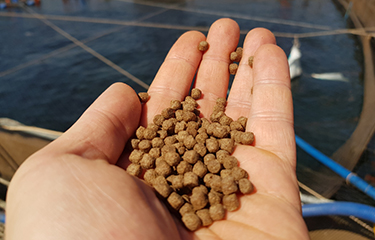After decades of growth, the aquaculture feed sector is experiencing deceleration and needs to adopt new strategies and business models to return to growth, claims a new report from Rabobank.
RaboResearch Food & Agribusiness’s “How to Succeed in Aqua Feed” analysis acknowledges that the global aquatic feed industry has experienced rapid growth and profitability, with sales driven by the rise of the aquaculture industry achieving an average annual growth rate of 8 percent since 1990. Another feature of the industry is the high price of aquatic feeds, which can range from USD 800 (EUR 723) to over USD 2,000 (EUR 1,808) per metric ton (MT), depending on species and region. This is much higher than the USD 200 (EUR 181) to USD 400 (EUR 362) per MT seen in the larger and more mature poultry and pork feed industry.
Authored by Gorjan Nikolik, Rabobank’s senior analyst for animal protein, the report states that the sector’s good profitability can also be attributed to the relatively high barriers to entry – mostly based on technical expertise – and due to the large difference in size between feed companies and the fragmented aquaculture farmers. Consequently, profitability margins have been higher than those in commoditized terrestrial feeds.
Furthermore, the good margins, combined with the high nominal value of the feed, has meant that, on a per-kilogram basis, the profitability of aquafeed substantially exceeds that of terrestrial proteins.
Despite the higher growth and profitability, Rabobank asserts that some areas of the aquaculture industry are now maturing, while others remain highly volatile due to the impact of diseases. It is also a sector that is continually driven by technological innovation and shifting market dynamics.
In response to the changing environment, and in order to maintain the growth and profitability seen in the past, the suggestion is that the aquafeed sector needs to re-evaluate its business model and consider “new, perhaps out-of-the-box options,” including the partial transformation of companies into aqua-technology suppliers or aqua-venture capitalists.
According to the report, in recent years, the main strategy deployed by aquafeed players has been to try and develop functional feeds – a way to reverse the commoditization of aquatic feed by adding medicinal or other functions to the feed. It argues that while there is nothing wrong in producing feed which is designed with a certain functionality, four other general strategic directions could potentially have a much larger impact on the aqua feed companies’ financial performance, but that this will require them to take a step beyond feed and expand their skill set.
The first recommendation is to accelerate the adoption of technologies (digitalization, data and automation) through partnerships for joint R&D and by investments into selected innovative companies.
“Ultimately, the combination of feed, data, and aquaculture farming technology can be one of the key drivers of growth and efficiency improvement for the industry,” the report states.
Secondly, aqua feed companies could produce complimentary products to feed, particularly focusing on genetics and animal health as a “powerful way to create value for farmers and improve the profitability of input suppliers.”
The third option is to develop novel feed ingredients. According to Rabobank’s report believes that as a group, such ingredients have the potential to transform not only the aquaculture industry, but in the long term, also the entire animal protein farming and global agriculture industry.
Last but not least, the report believes feed companies have the scope and financial clout to become more involved as investors and technology partners in new farming systems such as recirculating aquaculture systems (RAS) and offshore aquaculture. Part of this strategy to “drive the frontiers” of the industry includes supporting aquaculture growth in new regions, where aqua feed players can deliver the largest and most capital-intensive asset, the feed mill, while through JVs, partnerships, and investments, they could be instrumental in ensuring juvenile production, such as hatcheries, are set up, and training for farmers organized.
Similarly, there’s an opportunity to assist the commercialization of new species as well-positioned investors and partners.
“This is an opportunity for aqua feed companies to once again become more than just feed suppliers. They are the largest and best-financed entities in the farmed seafood industry,” the report states. “Their role at the center of the value chain means they have the knowledge to be able to evaluate many of the innovative projects, as well as the ability to commercially test these.”
Photo courtesy of Shutterstock







